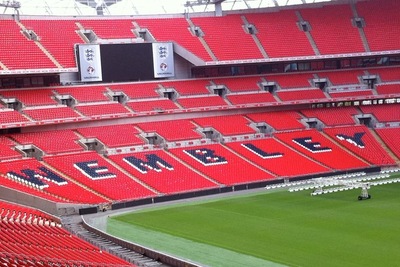
Football grounds are massive, you know. Like *really* big. Even small Premier League grounds can hold about 30,000 people. Think of a time in your life when you’ve thought the place you’ve been in was really busy.
On the train, for example, or when you’ve gone to the airport. The train might have had a couple of hundred people on it, the airport maybe a couple of thousand. If you put them inside a football ground it would still look dead empty.
But which are the largest football grounds in the UK, as far as capacity is concerned? Obviously some might be really big in the sense that they take up space, but they might be quite small as far as how many people they can fit inside them is concerned.
So which ones are just genuinely really big with the amount of room there is for supporters to get inside? We’ve being doing some research for you…
Top 10 Largest Football Grounds in the UK
| Stadium | Year Built | Current Capacity | Highest Attendance | Event |
|---|---|---|---|---|
| Wembley |
2002 – 2007 | 90,000 | 89,826 | Chelsea v Man United 19/05/2007 |
| Old Trafford |
1909 – 1910 | 75, 635 | 76,962 | Wolves v Grimsby 25/03/1939 |
| Principality Stadium |
1997 – 1999 | 74,500 | 72,500 | Wales v Italy 16/10/2002 |
| Tottenham Hotspur Stadium |
2016 – 2019 | 62,850 | 61,104 | Tottenahm v Chelsea 22/12/2019 |
| London Stadium |
2008 – 2011 | 62,500 | 59,988 | West Ham v Everton 30/03/2019 |
| Celtic Park |
1892 | 60,411 | 83,500 | Celtic v Rangers 01/01/1938 |
| The Emirates |
2004 – 2006 | 60,260 | 60,161 | Arsenal v Man United 03/11/2007 |
| The Etihad |
1999 – 2002 | 55,097 | 54,693 | Man City v Leicester 06/02/2016 |
| Anfield |
1884 | 54,000 | 61,905 | Liverpool v Wolves 02/02/1952 |
| St James’ Park |
1892 | 52,405 | 68,386 | Newcastle v Chelsea 03/09/1930 |
| Hampden Park |
1903 | 51,866 | 149,547 | Scotland v England 17/04/1937 |
1 – Wembley Stadium – England National Team
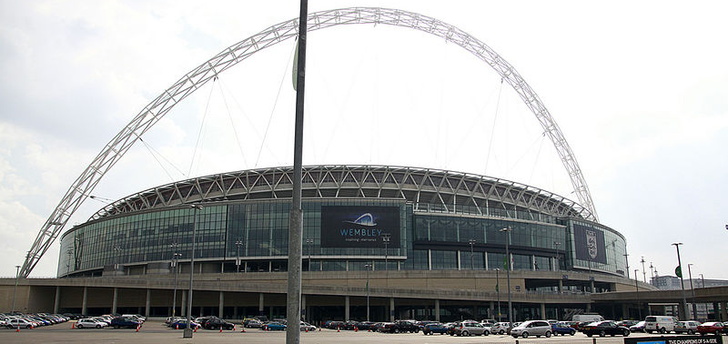
Build Cost – £974,000,000
Arguably one of the most famous stadiums in the world, the Wembley that stands today is not the same one that most of us will remember from our youths. Unless you were born after 2007 in which case…shut up. Wembley is, in essence, the home of the England national side; yet it’s also so much more than that.
We could attempt to be a bit poetic and tell you that it’s a symbol of the nation, a stadium that represents all that it is to be English. For some that might be true. For others ‘what it is to be English’ means white van drivers going around with St. George’s flags fluttering from their windows, wolf-whistling at passers-by. Plus, what we actually meant was that it’s a stadium that hosts most of the biggest games in the country.
As well as England matches you’ll also be able to see the FA Cup semi-finals and final at Wembley, plus the League Cup final and play-off finals from most divisions. On occasion it is also used to host high profile matches such as the Champions League final and, in the future, the final of the European Championships. It can host music concerts, with Muse setting the attendance record for their tour in 2007.
2 – Old Trafford – Manchester United
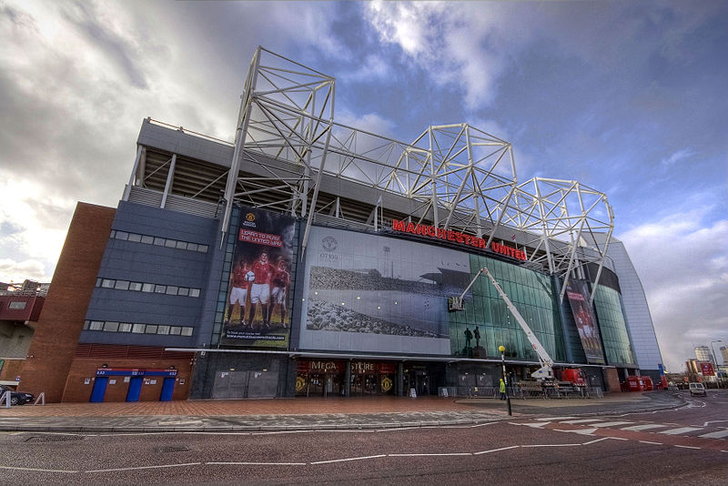
Build Cost – £90,000
Old Trafford is the home of Manchester United and has been ever since it opened in 1910. The stadium has plenty of ‘nods’ to the club’s illustrious past, including statues dedicated to both Matt Busby and Alex Ferguson and a stand named after the latter. The stadium has been developed a number of times, most significantly in the 1990s after the release of the Taylor Report into the Hillsborough Disaster.
The ground became an all-seater stadium in response to the FA’s decision to require that from all top-flight stadiums, temporarily reducing the capacity to 44,000 during the development phase. It bounced back, of course, and now boasts the largest capacity of a club-side stadium in the UK. As well as United games the ground has also been used to host FA Cup semi-finals in the past, rugby league and rugby union matches and music concerts from a number of artists.
3 – Principality Stadium – Wales National Team

Build Cost – £121,000,000
Better known to most as the Millennium Stadium, the Principality Stadium, so named because of sponsorship, is the occasional home of the Wales national football team and the permanent home of the Wales national rugby side. For many a football fan in England, though, it was the home of the FA Cup & League Cup finals when Wembley was being redeveloped from 2001 until 2007.
It’s predominantly used for rugby matches nowadays, and the most famous events held at the ground were for that sport. The 1999 rugby World Cup final, for example, or the finals of the Heineken Cup or Rugby League Challenge Cups which have been held there at regular intervals.
Like most major venues, of course, the Principality’s use isn’t just limited to sport. A number of music concerts have been held there since it opened in 1999. Welsh band Manic Street Preachers held a concert there on the eve of the new Millennium, whilst Bon Jovi, Madonna and The Rolling Stones have all appeared there too. It’s even been featured on film a few times including an episode of Doctor Who and the movie 28 Days Later.
4 – TOTTENHAM HOTSPUR STADIUM – TOTTENHAM HOTSPUR
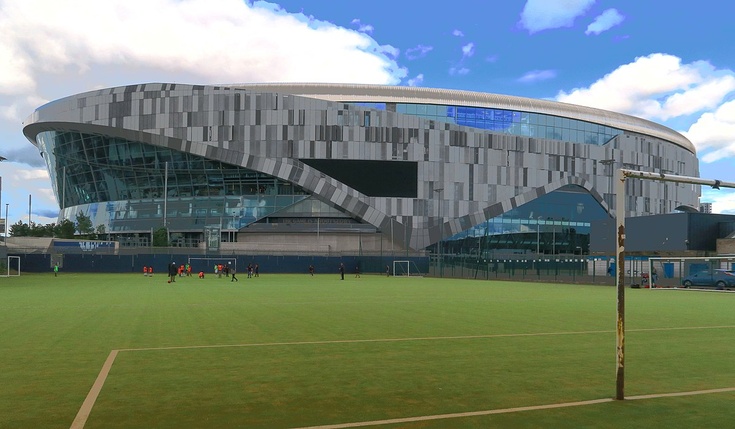
Build Cost – £1 Billion
Built to replace White Hart Lane, the unimaginatively named Tottenham Hotspur Stadium is the 3rd largest stadium in England and can lay claim to being the only pitch in the country with a dividable retracting pitch. This was built into the design to allow the stadium to be multi functional, as it also hosts NFL games, concerts, and the like.
The stadium was built on the site of the old ground, so some fans refer to it as the New White Hart Lane, but the naming rights are available and the hope is for a sponsor to emerge and inject some more cash into the club.
The plans for the new ground were actually first thrashed out in 2007, but several delays meant that the project didn’t break ground until 2016, but even then the stadium was still in use as parts of it were being demolished. When this eventually became impractical in May 2017, Spurs called Wembley their home for the interim years until the new stadium was ready.
The first game at their new home saw Tottenham entertaining Crystal Palace in a match they won 2-0, coincidentally the same score they achieved in their last game at the old White Hart Lane, when they beat Man Utd in 2017.
5 – London Stadium – West Ham United

Build Cost – £486,000,000
The London Stadium’s history is a brief but interesting one. Built specifically as the centrepiece for the summer Olympics when London was the host city in 2012, it has now been taken over by West Ham United and the successor to their old ground. Known for most of its existence as Upton Park but suddenly becoming The Boleyn Ground just as the Hammers were gearing up to leave it, the move to the Olympic Stadium has unquestionably helped West Ham up their game as fair as their home ground is concerned.
The stadium was the ‘jewel in the crown’ of the Olympics, not least of all when it hosted the opening ceremony of ‘The Greatest Show On Earth’. The event, which was directed by Danny Boyle, was a brilliant exploration of everything good about Great Britain. As well as football the ground has also hosted cricket, American football, baseball, motor racing and the the 2015 rugby World Cup.
6 – Celtic Park – Celtic

Build Cost – £35,000
The largest stadium in Scotland belongs to Celtic, one of the teams that contests the Old Firm derby every year along with their city neighbours Rangers. It opened in 1892 and, believe it or not, didn’t undergo any particularly huge changes until the 1990s. Yes cover was added to the terraces and floodlights were installed, but the ground was much the same in 1994 as it had been 112 years before.
The Taylor Report’s mandate that all stadiums should become all-seater affairs caused trouble for Celtic who couldn’t really afford to develop the ground. It wasn’t until the club was bought by Fergus McCann that work was able to be done one it, with a phased rebuild of the stadium carried out over the following four years, being completed in 1998.
As well as football matches the ground has also hosted Scotland international matches, athletics during the 2014 Commonwealth Games, shinty-hurling matches, rugby games, the Cycling World Championship in 1897 and a huge number of music concerts. The Who, Bryan Adams, Prince and Wet Wet Wet have all appeared on stage at the stadium at one point or another.
7 – Emirates Stadium
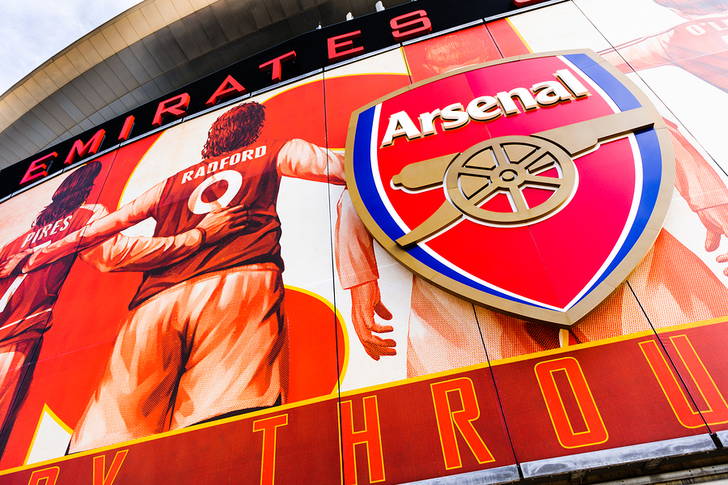
Build Cost – £470,000,000
The Emirates is Arsenal’s all-singing, all-dancing stadium that was built to replace their former home, Highbury. In England only Wembley and Old Trafford can welcome more supporters than The Emirates, with all three of them arguably having the same sterile atmosphere that comes with large, overly developed stadiums. The club has tried to combat this by going through a process of ‘Arsenalisation’ of the ground, but it will maintain its sterility as long as the club favours revenue over personality.
The ground was one of the first that broke from the English tradition of having four separate stands, instead opting for the more continental ‘bowl’ style appearance of continuous seating. As well as Arsenal matches it has also hosted, randomly, Brazil international friendly games. That has happened seven times in total, with only two of the games coming against ‘Home Nations’ in the form of Scotland and the Republic of Ireland. Music concerts can also be staged at the Emirates. Bruce Springsteen held the first there and Coldplay were the first band to sell out the stadium for a show.
8 – Etihad Stadium – Manchester City

Build Cost – £134,000,000
Manchester, somewhat ambitiously, wanted to host the Olympics in 2000. Part of their bid process was to come up with a stadium that could be the main location for most of the events, their version of the Olympic Stadium, if you will. In the end the city’s bid was rejected, but building of the City Of Manchester Stadium went ahead anyway. Though it was scant consolation, the ground was selected to host The Commonwealth Games in 2002.
After that it was converted into a football stadium and Manchester City decided to move in there when they left Maine Road. Known as The Etihad Stadium for sponsorship reasons, Manchester City have called it home since 2003. The capacity at the ground was 47,726 when it opened and increased to 55,097 when one of the stands was redeveloped. On top of City games and athletics meetings the stadium has also been used for rugby matches, boxing and a number of music concerts.
9 – Anfield – Liverpool

Build Cost – Unknown
One of the most iconic stadiums in world football, Anfield was originally the home of Liverpool’s city rivals Everton until a dispute over the rent caused them to move out to their own ground and left the stadium’s owner, John Houlding, with no team to play their football in the place. Consequently Liverpool Football Club was born and went on to become the most successful British football club of all time.
The biggest alteration to the stadium came in the wake of the Hillsborough Disaster, when 96 football supporters lost their lives because of police incompetence and an unsafe football ground. It meant that the stadium had to become an all-seater and the capacity was reduced to around 44,000. In 2016 The Main Stand was redeveloped, adding nearly 10,000 more seats to the ground’s capacity. As well as Liverpool matches Anfield has also hosted European Championship games in 1996, boxing, exhibition tennis and rugby league matches.
10 – St. James’ Park – Newcastle United

Build Cost – Unknown
Used for football since 1880, St. James’ Park has been Newcastle United’s home ground since 1892. There have been suggestions that the club would leave the stadium on several occasions because of the club’s desire to expand the size of the ground and the locals’ desire for that not to happen. Instead the stadium has been developed numerous times, giving it an oddly lopsided look.
The ground has been expanded, developed and changed a number of times during the 1990s, most notably in 1993 and 1998. Since 2007 it has been owned by the much lamented Mike Ashley, who has used the stadium to spread the name of his sports clothing company Sports Direct. It has hosted international football a number of times as well as rugby union and rugby league matches, charity games and music concerts.
11 – Hampden Park – Scotland National Team

Build Cost – Unknown
Creeping into the final secret eleventh spot on our top ten list of stadiums in the UK is Hampden Park. It’s the home of the Scotland national team and the amateur side Queens Park. It is, in many ways, like Scotland’s version of Wembley Stadium, and had it not been for Tottenham’s new ground it would have sat at number ten on the list. It hosts the later stages of the Scottish FA Cup and the Scottish League Cup.
The ground has been redeveloped a number of times with the capacity decreasing each time. In 1937 Scotland played England in an international match and 149,415 people had tickets. It’s believed that about 20,000 more got into the ground without tickets, though. It was redeveloped during the 1970s and the capacity was reduced to 74,370. It was used for The Commonwealth Games in 2014, numerous rugby union international matches, boxing and a whole host of concerts.
